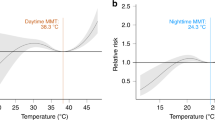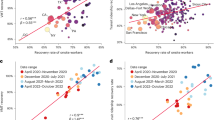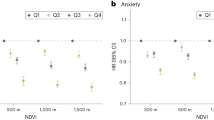Abstract
Measurements from central site (CS) monitors are often used as estimates of exposure in air pollution epidemiological studies. As these measurements are typically limited in their spatiotemporal resolution, true exposure variability within a population is often obscured, leading to potential measurement errors. To fully examine this limitation, we developed a set of alternative daily exposure metrics for each of the 169 ZIP codes in the Atlanta, GA, metropolitan area, from 1999 to 2002, for PM2.5 and its components (elemental carbon (EC), SO4), O3, carbon monoxide (CO), and nitrogen oxides (NOx). Metrics were applied in a study investigating the respiratory health effects of these pollutants. The metrics included: (i) CS measurements (one CS per pollutant); (ii) air quality model results for regional background pollution; (iii) local-scale AERMOD air quality model results; (iv) hybrid air quality model estimates (a combination of (ii) and (iii)); and (iv) population exposure model predictions (SHEDS and APEX). Differences in estimated spatial and temporal variability were compared by exposure metric and pollutant. Comparisons showed that: (i) both hybrid and exposure model estimates exhibited high spatial variability for traffic-related pollutants (CO, NOx, and EC), but little spatial variability among ZIP code centroids for regional pollutants (PM2.5, SO4, and O3); (ii) for all pollutants except NOx, temporal variability was consistent across metrics; (iii) daily hybrid-to-exposure model correlations were strong (r>0.82) for all pollutants, suggesting that when temporal variability of pollutant concentrations is of main interest in an epidemiological application, the use of estimates from either model may yield similar results; (iv) exposure models incorporating infiltration parameters, time-location-activity budgets, and other exposure factors affect the magnitude and spatiotemporal distribution of exposure, especially for local pollutants. The results of this analysis can inform the development of more appropriate exposure metrics for future epidemiological studies of the short-term effects of particulate and gaseous ambient pollutant exposure in a community.
This is a preview of subscription content, access via your institution
Access options
Subscribe to this journal
Receive 6 print issues and online access
$259.00 per year
only $43.17 per issue
Buy this article
- Purchase on Springer Link
- Instant access to full article PDF
Prices may be subject to local taxes which are calculated during checkout






Similar content being viewed by others
References
Zanobetti A, Schwartz J . The effect of fine and coarse particulate air pollution on mortality: a national analysis. Environ Health Perspect 2009; 117: 898–903.
Laden F, Schwartz J, Speizer FE, Dockery DW . Reduction in fine particulate air pollution and mortality: extended follow-up of the Harvard Six Cities Study. Am J Respir Crit Care Med 2006; 173: 667–672.
McKone TE, Ryan PB, Özkaynak H . Exposure information in environmental health research: Current opportunities and future directions for particulate matter, ozone, and toxic air pollutants. J Expo Sci Environ Epidemiol 2009; 19: 30–44.
Özkaynak H, Glenn B, Qualters JR, Strosnider H, McGeehin MA, Zenick H . Summary and findings of the EPA and CDC symposium on air pollution exposure and health. J Expo Sci Environ Epidemiol 2009; 19: 19–29.
Pope CA, Ezzati M, Dockery DW . Fine-particulate air pollution and life expectancy in the United States. N Engl J Med 2009; 360: 376–386.
Wilson JG, Kingham S, Pearce J, Sturman AP . A review of intraurban variations in particulate air pollution: Implications for epidemiological research. Atmos Environ 2005; 39: 6444–6462.
Jerrett M, Arain A, Kanaroglou P, Beckerman B, Potoglou D, Sahsuvaroglu T et al. A review and evaluation of intraurban air pollution exposure models. J Expo Anal Environ Epidemiol 2005; 15: 185–204.
Jerrett M, Arain MA, Kanaroglou P, Beckerman B, Crouse D, Gilbert NL et al. Modeling the Intraurban Variability of Ambient Traffic Pollution in Toronto, Canada. J Toxicol Environ Health Part A 2007; 70: 200–212.
Zeger SL, Thomas D, Dominici F, Samet JM, Schwartz J, Dockery D et al. Exposure measurement error in time-series studies of air pollution: concepts and consequences. Environ Health Perspect 2000; 108: 419–426.
Özkaynak H, Baxter L, Dionisio K, Burke J . Overview of air pollution exposure prediction approaches used in air pollution epidemiology studies. J Expo Sci Environ Epidemiol 2012 doi:10.1038/jes.2013.15 (this issue).
Cook R, Isakov V, Touma JS, Benjey W, Thurman J, Kinnee E et al. Resolving local-scale emissions for modeling air quality near roadways. J Air Waste Manag Assoc 2008; 58: 451–461.
Ivy D, Mulholland JA, Russell AG . Development of ambient air quality population-weighted metrics for use in time-series health studies. Journal of the Air & Waste Manag Assoc 2008; 58: 711–720.
Isakov V, Touma JS, Burke J, Lobdell DT, Palma T, Rosenbaum A et al. Combining regional- and local-scale air quality models with exposure models for use in environmental health studies. J Air Waste Manag Assoc 2009; 59: 461–472.
Georgopoulos P, Isukapalli S, Burke J, Napelenok S, Palma T, Langstaff J et al. Air quality modeling needs for exposure assessment from the source-to-outcome perspective. Air Waste Manag Assoc 2009, 26–35.
Hystad P, Demers PA, Johnson KC, Brook j, Donkelaar Av, Lamsal L et al. Spatiotemporal air pollution exposure assessment for a Canadian population-based lung cancer case-control study. Environ Health 2012; 11: 1–22.
Eeftens M, Beelen R, de Hoogh K, Bellander T, Cesaroni G, Cirach M et al. Development of Land Use Regression models for PM(2.5), PM(2.5) absorbance, PM(10) and PM(coarse) in 20 European study areas; results of the ESCAPE project. Environ Sci Technol 2012; 46: 11195–11205.
Zou B, Wilson JG, Zhan FB, Zeng Y . Air pollution exposure assessment methods utilized in epidemiological studies. J Environ Monit 2009; 11: 475–490.
Özkaynak H, Palma T, Touma JS, Thurman J . Modeling population exposures to outdoor sources of hazardous air pollutants. J Expo Sci Environ Epidemiol 2008; 18: 45–58.
Burke JM, Zufall MJ, Özkaynak H . A population exposure model for particulate matter: case study results for PM2.5 in Philadelphia, PA. J Expo Anal Environ Epidemiol 2001; 11: 470–489.
Chang HH, Reich BJ, Miranda ML . Time-to-event analysis of fine particle air pollution and preterm birth: results from North Carolina, 2001-2005. Am J Epidemiol 2012; 175: 91–98.
Wu J, Wilhelm M, Chung J, Ritz B . Comparing exposure assessment methods for traffic-related air pollution in an adverse pregnancy outcome study. Environ Res 2011; 111: 685–692.
Hoek G, Brunekreef B, Goldbohm S, Fischer P, Brandt PAvd . Association between mortality and indicators of traffic-related air pollution in the Netherlands: a cohort study. Lancet 2002; 360: 1203–1209.
Jerrett M, Burnett RT, Ma R, Pope CA, III, Krewski D, Newbold KB et al. Spatial analysis of air pollution and mortality in Los Angeles. Epidemiology 2005; 16: 727–736.
Delfino RJ, Chang J, Wu J, Ren C, Tjoa T, Nickerson B et al. Repeated hospital encounters for asthma in children and exposure to traffic-related air pollution near the home. Ann Allergy Asthma Immunol 2009; 102: 138–144.
Laurent O, Pedrono G, Segala C, Filleul L, Havard S, Deguen S et al. Air pollution, asthma attacks, and socioeconomic deprivation: a small-area case-crossover study. Am J Epidemiol 2008; 168: 58–65.
Laurent O, Pedrono G, Filleul L, Segala C, Lefranc A, Schillinger C et al. Influence of socioeconomic deprivation on the relation between air pollution and β-agonist sales for asthma. Chest 2009; 135: 717–723.
Reich BJ, Fuentes M, Burke J . Analysis of the effects of ultrafine particulate matter while accounting for human exposure. Environmetrics 2009; 20: 131–146.
Shaddick G, Lee D, Zidek JV, Salway R . Estimating exposure response functions using ambient pollution concentrations. Ann Appl Stat 2008; 2: 1249–1270.
Zhu Y, Hinds WC, Kim S, Shen S, Sioutas C . Study of ultrafine particles near a major highway with heavy-duty diesel traffic. Atmos Environ 2002; 36: 4323–4335.
Gilbert NL, Goldberg MS, Beckerman B, Brook JR, Jerrett M . Assessing spatial variability of ambient nitrogen dioxide in Montreal, Canada, with a land-use regression model. J Air Waste Manag Assoc 2005; 55: 1059–1063.
Wade KS, Mulholland JA, Marmur A, Russell AG, Hartsell B, Edgerton E et al. Effects of instrument precision and spatial variability on the assessment of the temporal variation of ambient air pollution in Atlanta, Georgia. J Air Waste Manag Assoc 2006; 56: 876–888.
Kirby C, Greig A, Drye T . Temporal and spatial variations in nitrogen dioxide concentrations across an urban landscape: Cambridge, UK. Environ Monit Assess 1998; 52: 65–82.
Bari A, Dutkiewicz VA, Judd CD, Wilson LR, Luttinger D, Husain L . Regional sources of particulate sulfate, SO2, PM2.5, HCL and HNO3 in New York, NY. Atmos Environ 2003; 37: 2837–2844.
Husain L, Dutkiewicz VA . A long-term (1975-1988) study of atmospheric SO42-: regional contributions and concentration trends. Atmos Environ 1990; 24A: 1175–1187.
Butler AJ, Andrew MS, Russell AG . Daily sampling of PM2.5 in Atlanta: results of the first year of the Assessment of Spatial Aerosol Composition in Atlanta study. J Geophys Res 2003; 108: 8415–8426.
Pinto JP, Lefohn AS, Shadwick DS . Spatial variability of PM2.5 in Urban Areas in the United States. J Air Waste Manag Assoc 2004; 54: 440–449.
Sarnat SE, Sarnat JA, Mulholland J, Isakov V, Özkaynak H, Chang H et al. Application of alternative spatiotemporal metrics of ambient air pollution exposure in a time-series epidemiological study in Atlanta. J Expo Sci Environ Epidemiol 2012 doi:10.1038/jes.2013.41 (this issue).
Sarnat JA, Sarnat SE, Chang H, Mulholland J, Özkaynak H, Isakov V . Spatiotemporally-resolved air exchange rate as a modifier of acute air pollution related morbidity. J Expo Sci Environ Epidemi 2013 doi:10.1038/jes.2013.32 (this issue).
Tolbert PE, Klein M, Metzger KB, Peel J, Flanders WD, Todd K et al. Interim results of the study of particulates and health in Atlanta (SOPHIA). J Expo Anal Environ Epidemiol 2000; 10: 446–460.
Peel JL, Tolbert PE, Klein M, Metzger KB, Flanders WD, Todd K et al. Ambient air pollution and respiratory emergency department visits. Epidemiology 2005; 16: 164–174.
Metzger KB, Tolbert PE, Klein M, Peel JL, Flanders WD, Todd K et al. Ambient air pollution and cardiovascular emergency department visits. Epidemiology 2004; 15: 46–56.
Hansen DA, Edgerton E, Hartsell B, Jansen J, Burge H, Koutrakis P et al. Air quality measurements for the aerosol research and inhalation epidemiology study. J Air Waste Manag Assoc 2006; 56: 1445–1458.
Cimorelli AJ, Perry SG, Venkatram A, Weil JC, Paine RJ, Wilson RB et al. AERMOD: a dispersion model for industrial source applications. Part I: General model formulation and boundary layer characterization. J Appl Meteorol Climatol 2005; 44: 682–693.
Georgopoulos PG, Wang S-W, Vyas VM, Sun Q, Burke J, Vedantham R et al. A source-to-dose assessment of population exposures to fine PM and ozone in Philadelphia, PA during a summer 1999 episode. J Expo Anal Environ Epidemiol 2005; 15: 439–457.
Cao Y, Frey HC . Geographic differences in inter-individual variability of human exposure to fine particulate matter. Atmos Environ 2011; 45: 5684–5691.
US EPA. Total Risk Integrated Methodology (TRIM) Air Pollutants Exposure Model Documentation (TRIM.Expo/APEX, Version 4.5), Volume I: User's Guide 2012 US EPA Office of Air Quality Planning and Standards, Research Triangle Park, NC, EPA-452/B-12-001a.
US EPA. Total Risk Integrated Methodology (TRIM) Air Pollutants Exposure Model Documentation (TRIM.Expo/APEX, Version 4.5), Volume II: Technical Support Document 2012 US EPA Office of Air Quality Planning and Standards, Research Triangle Park, NC, EPA-452/B-12-001b.
McCurdy T, Glen G, Smith L, Lakkadi Y . The National Exposure Research Laboratory's Consolidated Human Activity Database. J Expo Anal Environ Epidemiol 2000; 10 (6 Pt 1): 566–578.
US Department of Transportation Bureau of Transportation Statistics Census Transportation Planning Package (CTPP) 2000. Part 3 - Journey to Work 2000 Available from http://transtats.bts.gov.
Westerdahl D, Fruin S, Sax T, Fine PM, Sioutas C . Mobile platform measurements of ultrafine particles and associated pollutant concentrations on freeways and residential streets in Los Angeles. Atmos Environ 2005; 39: 3597–3610.
Sarnat JA, Koutrakis P, Suh HH . Assessing the relationship between personal particulate and gaseous exposures of senior citizens living in Baltimore, MD. J Air Waste Manag Assoc 2000; 50: 1184–1198.
Sarnat JA, Schwartz J, Catalano PJ, Suh HH . Gaseous pollutants in particulate matter epidemiology: confounders or surrogates? Environ Health Perspect 2001; 109: 1053–1061.
Brunekreef B, Janssen NA, de Hartog J, Oldenwening M, Meliefste K, Hoek G et al. Personal, indoor, and outdoor exposures to PM2.5 and its components for groups of cardiovascular patients in Amsterdam and Helsinki. Res Rep Health Eff Inst 2005; 127: 1–70.
Janssen NA, Lanki T, Hoek G, Vallius M, De Hartog J, Van Grieken R et al. Associations between ambient, personal, and indoor exposure to fine particulate matter constituents in Dutch and Finnish panels of cardiovascular patients. Occup Environ Med 2005; 62: 868–877.
Liu L-JS, Delfino R, Koutrakis P . Ozone Exposure Assessment in a Southern California Community. Environ Health Perspect 1997; 105: 58–65.
Williams R, Jones P, Croghan C, Thornburg J, Rodes C . The influence of human and environmental exposure factors on personal NO2 exposures. J Expo Sci Environ Epidemiol 2012; 22: 109–115.
Sarnat SE, Klein M, Sarnat JA, Flanders WD, Waller LA, Mulholland JA et al. An examination of exposure measurement error from air pollutant spatial variability in time-series studies. J Expo Sci Environ Epidemiol 2010; 20: 135–146.
Strickland MJ, Darrow LA, Klein M, Flanders WD, Sarnat JA, Waller LA et al. Short-term associations between ambient air pollutants and pediatric asthma emergency department visits. Am J Respir Crit Care Med 2010; 182: 307–316.
Tolbert PE, Klein M, Peel JL, Sarnat SE, Sarnat JA . Multipollutant modeling issues in a study of ambient air quality and emergency department visits in Atlanta. J Expo Sci Environ Epidemiol 2007; 17 (Suppl 2): S29–S35.
Goldman GT, Mulholland JA, Russell AG, Srivastava A, Strickland MJ, Klein M et al. Ambient air pollutant measurement error: characterization and impacts in a time-series epidemiologic study in Atlanta. Environ Sci Technol 2010; 44: 7692–7698.
Goldman GT, Mulholland JA, Russell AG, Gass K, Strickland MJ, Tolbert PE . Characterization of ambient air pollution measurement error in a time-series health study using a geostatistical simulation approach. Atmos Environ 2012; 57: 101–108.
Bell ML, Dominici F, Ebisu K, Zeger SL, Samet JM . Spatial and temporal variation in PM2.5 chemical composition in the United States for health effects studies. Environ Health Perspect 2007; 115: 989–995.
Mauderly JL, Burnett RT, Castillejos M, Özkaynak H, Samet JM, Stieb DM et al. Is the air pollution health research community prepared to support a multipollutant air quality management framework? Inhal Toxicol 2010; 22: 1–19.
Özkaynak H, Isakov V, Sarnat S, Sarnat J, Mulholland J . Examination of different exposure metrics in an epidemiological study. Air Waste Manag Assoc Magazine Environ Manag 2011, 22–27.
Goldman GT, Mulholland JA, Russell AG, Strickland MJ, Klein M, Waller LA et al. Impact of exposure measurement error in air pollution epidemiology: effect of error type in time-series studies. Environ Health 2011; 10: 1–11.
US EPA. Integrated Science Assessment for Particulate Matter. Research Triangle Park, NC: National Center for Environmental Assessment-RTP Division, Office of Research and Development, US Environmental Protection Agency, 2009.
Acknowledgements
We thank James Crooks of the US EPA’s National Health and Environmental Effects Research Laboratory for contributions to the modeling portion of this work, David Brzezinski of the US EPA’s Office of Transportation and Air Quality, Sarav Arunachalam of the University of North Carolina Institute for the Environment, Jon Morton of the Georgia Department of Natural Resources, and Joe Touma formerly of the US EPA’s National Exposure Research Laboratory for their efforts related to air quality modeling, a refined local emissions inventory, and traffic data support. We thank EPA internal reviewers for their comments on the manuscript. The US EPA through its Office of Research and Development, National Exposure Research Laboratory, funded and collaborated in the research described here under cooperative agreement number CR-83407301-1 to Emory University, and a US EPA Clean Air Research Center grant to Emory University and the Georgia Institute of Technology (RD83479901). It has been subjected to Agency review and approved for publication.
Author information
Authors and Affiliations
Corresponding author
Ethics declarations
Competing interests
The authors declare no conflict of interest.
Additional information
Supplementary Information accompanies the paper on the Journal of Exposure Science and Environmental Epidemiology website
Supplementary information
Rights and permissions
About this article
Cite this article
Dionisio, K., Isakov, V., Baxter, L. et al. Development and evaluation of alternative approaches for exposure assessment of multiple air pollutants in Atlanta, Georgia. J Expo Sci Environ Epidemiol 23, 581–592 (2013). https://doi.org/10.1038/jes.2013.59
Received:
Accepted:
Published:
Issue Date:
DOI: https://doi.org/10.1038/jes.2013.59
Keywords
This article is cited by
-
Comparison of measured residential black carbon levels outdoors and indoors with fixed-site monitoring data and with dispersion modelling
Environmental Science and Pollution Research (2021)
-
Population dynamics based on mobile phone data to improve air pollution exposure assessments
Journal of Exposure Science & Environmental Epidemiology (2019)
-
A simulation study to quantify the impacts of exposure measurement error on air pollution health risk estimates in copollutant time-series models
Environmental Health (2016)
-
The importance of the exposure metric in air pollution epidemiology studies: When does it matter, and why?
Air Quality, Atmosphere & Health (2016)
-
Use of an exposure model to explore the impact of residential proximity to a highway on exposures to air pollutants of an ambient origin
Air Quality, Atmosphere & Health (2016)



